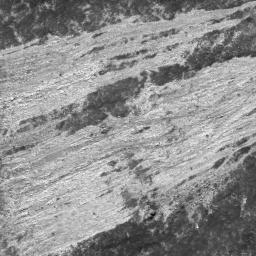
|
Moon or Abstract Expressionism?
- Click the image above for a larger view
- Full-Res JPEG (1200 x 1200) (352.2 kB)
- Full-Res TIFF (1200 x 1200) (1.4 MB)
Caption:
Seeing small areas of the Moon at 50 cm per pixel often presents unexpected views, and sometimes it is hard to interpret the geology at first glance, much less what is up and what is down! What are the white streaks? How did they get there? Image is 600 meters wide, from NAC frame M109624226L.
The white streamers are located on the west wall of a 6-km diameter unnamed crater lying near the center of the 42-km diameter crater Henry Frères (23.5°S, 58.9°W).The crater rim is to the west (left) and the floor to the right (east), thus downhill is to the right. The streamers are composed of blocky material, individual blocks are up to several meters in diameter, that slid down the crater wall towards the floor. Most of the material halted before it reached the crater floor.
Background Info:
NASA's Goddard Space Flight Center built and manages the mission for the Exploration Systems Mission Directorate at NASA Headquarters in Washington. The Lunar Reconnaissance Orbiter Camera was designed to acquire data for landing site certification and to conduct polar illumination studies and global mapping. Operated by Arizona State University, the LROC facility is part of the School of Earth and Space Exploration (SESE). LROC consists of a pair of narrow-angle cameras (NAC) and a single wide-angle camera (WAC). The mission is expected to return over 70 terabytes of image data.
Cataloging Keywords:
| Name | Value | Additional Values |
|---|---|---|
| Target | Moon | |
| System | Earth | |
| Target Type | Satellite | |
| Mission | Lunar Reconnaissance Orbiter (LRO) | |
| Instrument Host | Lunar Reconnaissance Orbiter | |
| Host Type | Orbiter | |
| Instrument | Lunar Reconnaissance Orbiter Camera (NAC) | |
| Detector | Narrow Angle Camera (NAC), Wide Angle Camera (WAC) | |
| Extra Keywords | Crater, Grayscale | |
| Acquisition Date | ||
| Release Date | 2009-12-22 | |
| Date in Caption | ||
| Image Credit | NASA/GSFC/Arizona State University | |
| Source | photojournal.jpl.nasa.gov/catalog/PIA12936 | |
| Identifier | PIA12936 | |
